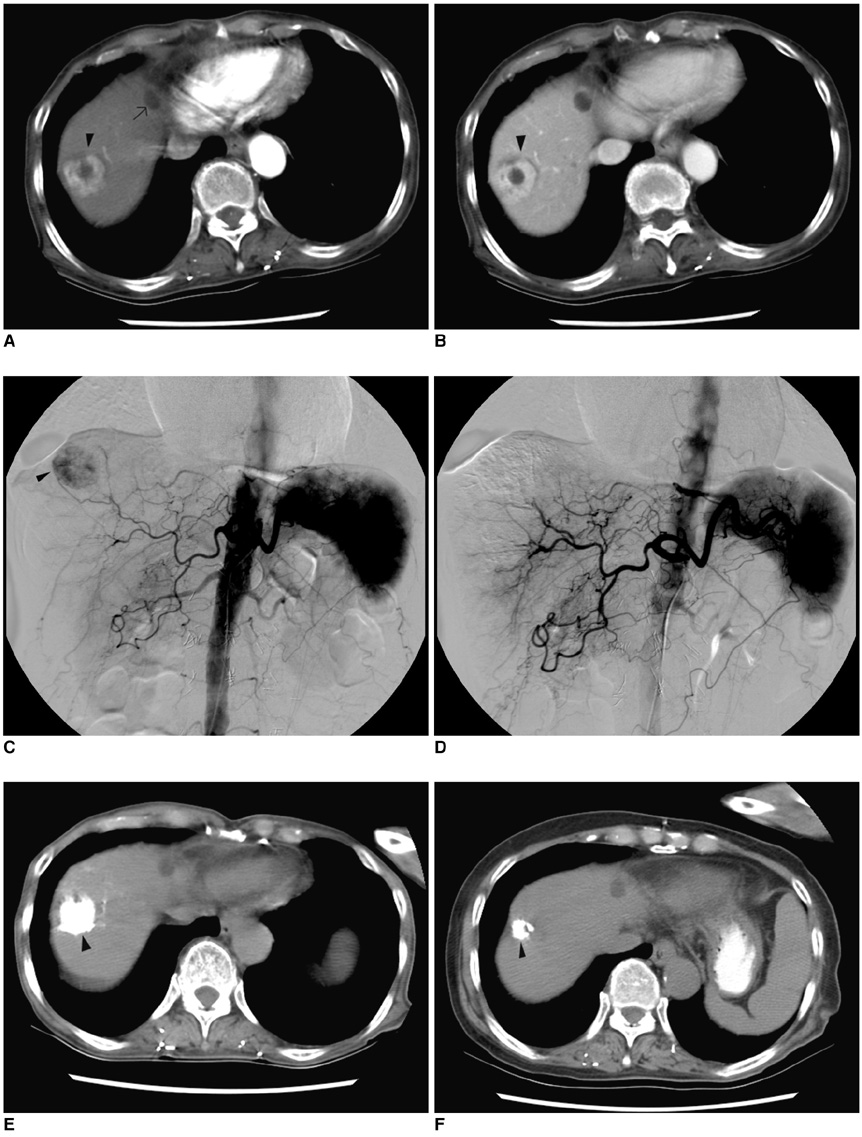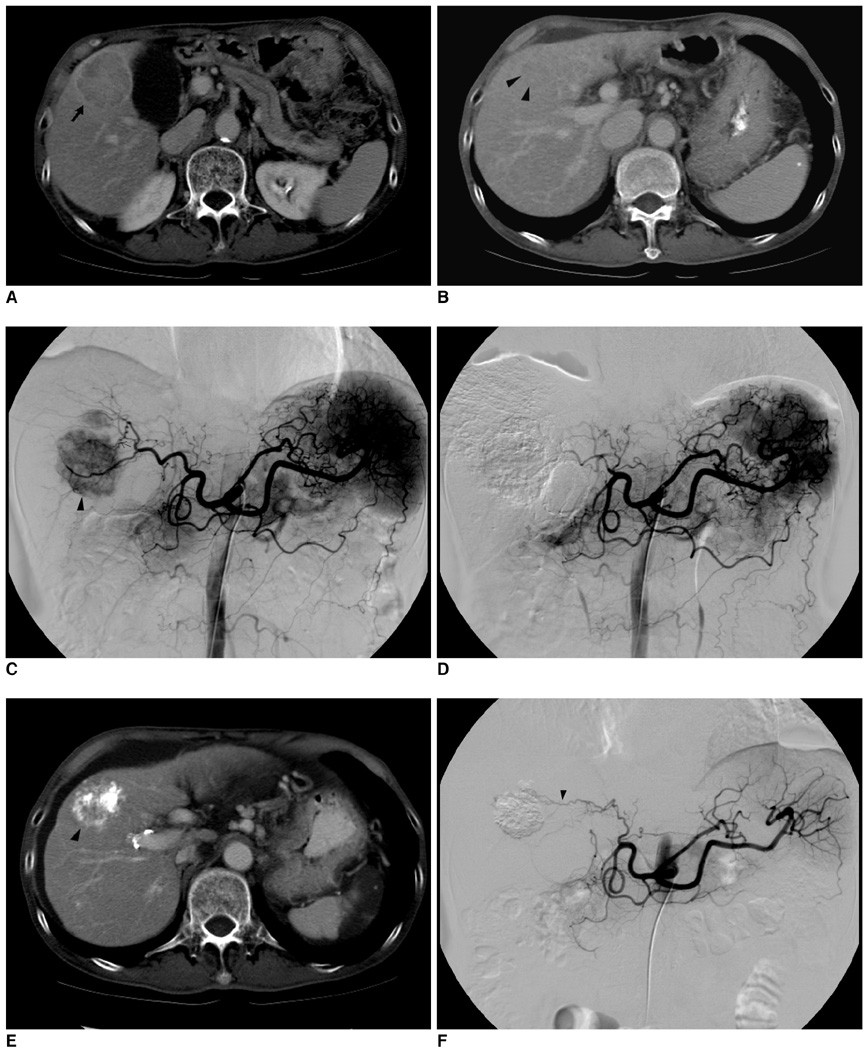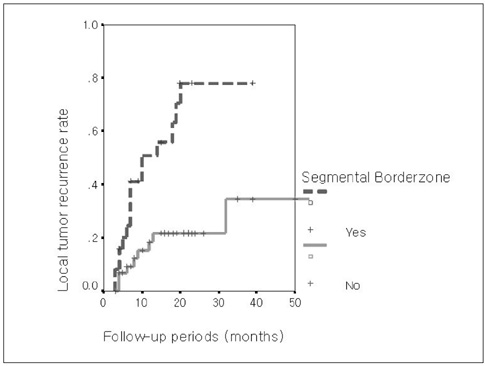Korean J Radiol.
2006 Dec;7(4):267-274. 10.3348/kjr.2006.7.4.267.
Risk Factors for Local Tumor Recurrence after Segmental Transarterial Chemoembolization for Hepatocellular Carcinoma: the Importance of Tumor Located in the Segmental Border Zone
- Affiliations
-
- 1Department of Radiology, Seoul Veterans Hospital, Seoul, Korea.yunkucho2004@yahoo.co.kr
- 2Department of Radiology and Institute of Radiation Medicine, Seoul National University College of Medicine, Seoul, Korea.
- 3Department of Internal Medicine, Seoul Veterans Hospital, Seoul, Korea.
- KMID: 1092550
- DOI: http://doi.org/10.3348/kjr.2006.7.4.267
Abstract
OBJECTIVE
We wanted to evaluate whether tumors located in a segmental border zone are predisposed to local recurrence after performing segmental transarterial chemoembolization for hepatocellular carcinoma. MATERIALS AND METHODS: Seventy-three hepatocellular carcinoma nodules were retrospectively analyzed for local tumor recurrence after performing segmental transarterial chemoembolization by using follow-up CT studies (median follow-up period: 20 months, range: 4-77 months). The tumors were divided into two groups according to whether the lesions were located at the segmental border zone (Group I) or not (Group II). Comparison of the tumor characteristics and chemoembolization methods between the two groups was performed using the chi-square test. The local recurrence rates were compared by Kaplan-Meyer method and analyzed with the log rank test. RESULTS: Local tumor recurrence occurred for 25 hepatocellular carcinoma nodules (42.9%). The follow-up periods, tumor characteristics and chemoembolization methods between Groups l and ll were comparable. The local recurrence rate was 64.0% (16/25) in Group I and 18.8% (9/48) in Group II. The difference was statistically significant on the univariate and multivariate analyses (p = 0.000 for both). CONCLUSION: Tumor location in a segmental border zone was a significant risk factor for local tumor recurrence after performing segmental transarterial chemoembolization for hepatocellular carcinoma.
MeSH Terms
-
Risk Factors
Retrospective Studies
Proportional Hazards Models
Neoplasm Recurrence, Local
Middle Aged
Male
Liver Neoplasms/*pathology/*therapy
Iodized Oil/administration & dosage
Humans
Female
Doxorubicin/administration & dosage
Chi-Square Distribution
*Chemoembolization, Therapeutic
Carcinoma, Hepatocellular/*pathology/*therapy
Aged
Adult
Figure
Reference
-
1. Colella G, Bottelli R, De Carlis L, Sansalone CV, Rondinara GF, Alberti A, et al. Hepatocellular carcinoma: comparison between liver transplantation, resective surgery, ethanol injection, and chemoembolization. Transpl Int. 1998. 11:S193–S196.2. Segawa T, Izawa K, Tsunoda T, Kanematsu T, Shima M, Matsunaga N, et al. Evaluation of hepatectomy in small hepatocellular carcinoma: comparison with transcatheter arterial embolization therapy. Nippon Geka Gakkai Zasshi. 1992. 93:1095–1099.3. Nakamura H, Hashimoto T, Oi H, Sawada S. Transcatheter oil chemoembolization of hepatocellular carcinoma. Radiology. 1989. 170:783–786.4. Bronowicki JP, Vetter D, Dumas F, Boudjema K, Bader R, Weiss AM, et al. Transcatheter oil chemoembolization for hepatocellular carcinoma: A 4-year study of 127 French patients. Cancer. 1994. 74:16–24.5. Uchida H, Ohishi H, Matsuo N, Nishimine K, Ohue S, Nishimura Y, et al. Transcatheter hepatic segmental arterial embolization using lipiodol mixed with anticancer drug and Gelfoam particles for hepatocellular carcinoma. Cardiovasc Intervent Radiol. 1990. 13:140–145.6. Takayasu K, Suzuki M, Uesaka K, Muramatsu Y, Moriyama N, Yoshida T, et al. Hepatic arterial embolization for inoperable hepatocellular carcinoma: prognosis and risk factors. Cancer Chemother Pharmacol. 1989. 23:S123–S125.7. Yamada R, Kishi K, Sonomura T, Tsuda M, Nomura S, Satoh M. Transcatheter arterial embolization in unresectable hepatoellular carcinoma. Cardiovasc Intervent Radiol. 1990. 13:135–139.8. Pelletier G, Rohe A, Ink O, Anciaux ML, Derhy S, Rougier P, et al. A randomized trial of hepatic arterial chemoembolization in patients with unresectable hepatocellular carcinoma. J Hepatol. 1990. 11:181–184.9. Takayasu K, Muramatsu Y, Maeda T, Iwata R, Furukawa H, Muramatsu Y, et al. Targeted transarterial oily chemoembolization for small foci of hepatocellular carcinoma using a unified helical CT and angiography system: analysis of factors affecting local recurrence and survival rates. AJR Am J Roentgenol. 2001. 176:681–688.10. Maeda S, Fujiyama S, Tanaka M, Ashihara H, Hirata R, Tomita K. Survival and local recurrence rates of hepatocellular carcinoma patients treated by transarterial chemolipiodolization with and without embolization. Hepatol Res. 2002. 23:202–210.11. Nguyen M, Garcia R, Simpson P, Wright T, Keeffe E. Racial differences in effectiveness of alpha-fetoprotein for the diagnosis of hepatocellular carcinoma in hepatitis C cirrhosis. Hepatology. 2002. 36:410–417.12. Fischer L, Cardenas C, Thorn M, Benner A, Grenacher L, Lehnert T, et al. Limits of Couinaud's liver segment classification: a quantitative computer-based three-dimensional analysis. J Comput Assist Tomogr. 2002. 26:962–967.13. Choi D, Choo SW, Lim JH, Lee SJ, Do YS, Choo IW. Opacification of the intrahepatic portal veins during CT hepatic arteriography. J Comput Assist Tomogr. 2001. 25:218–224.14. Choi SH, Chung JW, Lee HS. Hepatocellular carcinoma supplied by portal flow after repeated transcatheter arterial chemoembolization. AJR Am J Roentgenol. 2003. 181:889–890.
- Full Text Links
- Actions
-
Cited
- CITED
-
- Close
- Share
- Similar articles
-
- Local Recurrence of Hepatocellular Carcinoma after Segmental Transarterial Chemoembolization: Risk Estimates Based on Multiple Prognostic Factors
- Hemoperitoneum Secondary to Rupture of Metastatic Hepatocellular Carcinoma : A Case Report
- Complete Remission with Transarterial Chemoembolization in a Patient with Hepatocellular Carcinoma Who Showed Early Recurrence following Surgical Resection
- Aggressive tumor recurrence after radiofrequency ablation for hepatocellular carcinoma
- Rupture of hepatocellular carcinoma after transcatheter arterial chemoembolization: A case report




